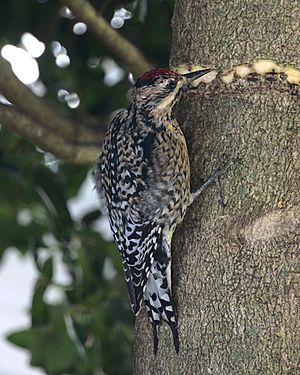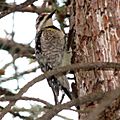Yellow-bellied sapsucker facts for kids
The yellow-bellied sapsucker (Sphyrapicus varius) is a medium-sized woodpecker. These birds live and breed in Canada and the northeastern United States.
Quick facts for kids Yellow-bellied sapsucker |
|
|---|---|
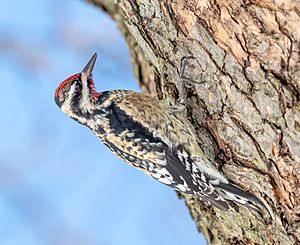 |
|
| Male | |
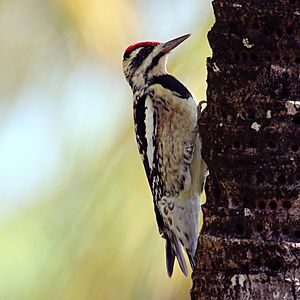 |
|
| Female, Cuba | |
| Conservation status | |
| Scientific classification | |
| Genus: |
Sphyrapicus
|
| Species: |
varius
|
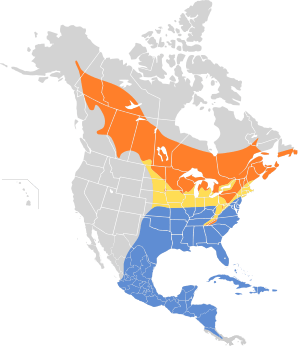 |
|
| Synonyms | |
|
Picus varius Linnaeus, 1766 |
|
Contents
- Understanding Yellow-bellied Sapsucker Classification
- Yellow-bellied Sapsucker Appearance
- Yellow-bellied Sapsucker Homes and Travel
- Yellow-bellied Sapsucker Behavior and Life Cycle
- Yellow-bellied Sapsucker Dangers
- Yellow-bellied Sapsuckers and People
- Yellow-bellied Sapsucker Conservation Status
- Images for kids
- See also
Understanding Yellow-bellied Sapsucker Classification
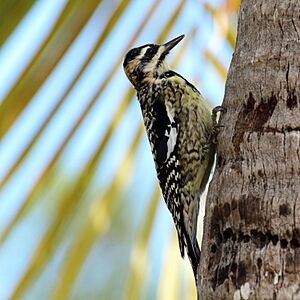
The way we name and group living things is called taxonomy. The yellow-bellied sapsucker was first described by an English naturalist named Mark Catesby. He drew and wrote about it between 1729 and 1732.
Later, in 1766, a Swedish scientist named Carl Linnaeus gave it its scientific name, Picus varius. The word varius means "various" or "colorful" in Latin. Today, this bird is part of the genus Sphyrapicus. The yellow-bellied sapsucker is closely related to the red-breasted sapsucker and the Red-naped sapsucker.
Yellow-bellied Sapsucker Appearance
The yellow-bellied sapsucker is about 19 to 21 centimeters (7.5 to 8.3 inches) long. It usually weighs around 50 grams (1.8 ounces). Its wings can spread out from 34 to 40 centimeters (13.4 to 15.8 inches).
Male and Female Differences
Male sapsuckers have a bright red forehead. Females have a lighter red forehead, or sometimes no red at all. The male's throat and chin are red, while the female's are white.
Both sexes have a black border around their red crown. A white stripe goes from above the eye to the back of the neck. There is also a wide black stripe through the ear area. Below this, a white stripe runs from the nose to the side of the chest.
Body Colors and Markings
The back of the sapsucker is white with black bars. The lower back is white. Their wing feathers are black with white tips. The underside of the wings is striped grey and white.
The upper tail is black, sometimes with white tips on the outer feathers. The belly area has a yellow tint, becoming whiter lower down. The sides of the chest have black, arrowhead-shaped markings.
Young Sapsuckers
Young sapsuckers are mostly dark olive-brown. They have a striped head and a streaked crown. Their throat is usually white, but young males might have some red. Their chest looks scaly, and the middle of their belly is very pale yellow. Their tail has more bars than an adult's.
Sapsucker Sounds and Communication
Yellow-bellied sapsuckers make different sounds. Males often use a long, nasal "neaaah" or "wee-wee-wee-wee" call. They use these sounds to attract a mate when breeding starts.
When family members meet, they make soft "week week" or "wurp wurp" calls. If they are alarmed, they make a soft "mew" sound. This sound gets louder if the danger increases.
Sapsuckers also "drum" on trees. They choose dead trees that make a loud sound. Their drumming starts fast and then slows down. These drums help them talk to other sapsuckers from far away.
Birds Similar to Sapsuckers
- The red-naped sapsucker has a red patch on the back of its head.
- The hairy woodpecker has no red on its head or throat. Its back is blacker.
- The downy woodpecker looks like the hairy woodpecker but is much smaller.
Yellow-bellied Sapsucker Homes and Travel
Yellow-bellied sapsuckers live in Canada, eastern Alaska, and the northeastern United States. In winter, they fly south to the eastern United States, the West Indies, and Central America. Sometimes, they are seen in Ireland and Great Britain, but this is very rare.
Where They Live
During breeding season, they live in forests with both deciduous (trees that lose leaves) and coniferous (evergreen) trees. These forests can be up to 2,000 meters (6,560 feet) high.
In winter, they also live in forests. They can be found at the edge of forests, in open woodlands, and even in suburban areas with large trees. They can live from sea level up to 3,400 meters (11,150 feet) high.
Yellow-bellied Sapsucker Behavior and Life Cycle
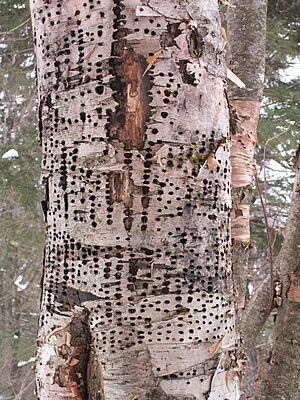
How Sapsuckers Find Food
Yellow-bellied sapsuckers usually look for food alone. Sometimes in winter, they join small groups. Their diet mainly includes insects, tree sap, fruits, and nuts. They also eat parts of trees called bast and cambium.
In spring, they sometimes eat tree buds. During nesting season, insects make up about half of what adults eat. In late summer and autumn, sap becomes their main food. They eat cambium all year, especially in winter and spring. Fruit is mostly eaten from October to February.
Feeding Their Young
Both male and female sapsuckers feed their chicks. They mostly give them insects, sometimes coated in tree sap. Younger chicks get smaller insects. The chicks make loud calls to ask for food. The hungriest chick usually gets fed first.
When young sapsuckers leave the nest, they still get insects from their parents. They also start drinking sap from the holes their parents drill.
Favorite Trees for Sap
During breeding season, sapsuckers like to get sap from paper birch, red maple, and aspen trees. They also use other types of birch, maple, willow, hickory, alder, pine, spruce, and fir trees. In winter, they often feed on evergreen trees. In autumn, they prefer trees with rough bark.
Before they start feeding a lot on a tree, sapsuckers drill small "exploratory" holes. These holes are in horizontal rows. Once they find a good tree, they drill more holes in columns. These holes are oval-shaped at first, then made taller to get more sap. The top holes provide fresh sap. They also eat the soft inner bark (bast) from the edges of the holes.
Yellow-bellied Sapsucker Reproduction
Yellow-bellied sapsuckers build their nests in holes they dig in live deciduous trees. They often choose trees with soft, rotten wood inside. They especially like aspen trees that have a certain type of fungus.
Both the male and female work together to dig the nest hole. The male does most of the digging. It takes about 15 to 28 days to dig the hole. The nest cavity is usually 3 to 14 meters (10 to 46 feet) above the ground.
These birds are monogamous, meaning they stay with one partner. They also protect their territory around the nest. This area can be from 45 to 137 meters (150 to 450 feet) away from the nest.
The male usually arrives at the nesting area about a week before the female. The breeding season is from April to July.
Courtship and Eggs
During courtship, the male might flap his wings quickly below the female. This helps them bond. They also bob their heads and open their wings halfway. They might touch their bills together.
The female lays 4 to 7 white, spotless eggs. Birds in the northern parts of their range lay more eggs. The eggs are about 24 by 17 millimeters (0.94 by 0.67 inches).
Both parents take turns sitting on the eggs. This is called incubation. It lasts 10 to 13 days. The male usually incubates at night.
Raising the Chicks
Once the chicks hatch, both parents keep them warm for 8 to 10 days. This is called brooding. Nests with fewer chicks are brooded more.
After 25 to 29 days, the young birds leave the nest for the first time. They become independent after about two more weeks.
Yellow-bellied Sapsucker Dangers
Sapsuckers can be affected by tiny parasites. They can also be attacked by predators. Raccoons can kill adult sapsuckers and their young, especially if the nest is too low or not deep enough. Snakes are also predators of sapsucker nests.
Yellow-bellied Sapsuckers and People
Damage to Trees
Because of how they feed, yellow-bellied sapsuckers can sometimes hurt trees. Their feeding holes can attract insects. Sometimes, they can even kill a tree. This happens when they drill a ring of holes all around the tree trunk. This is called girdling.
Girdling stops the tree from moving water and nutrients. Some trees are more likely to die after being damaged by sapsuckers. For example, paper birch and red maple trees are often killed. Other trees, like red spruce and eastern hemlock, are much less likely to die from sapsucker damage.
Yellow-bellied Sapsucker Conservation Status
The yellow-bellied sapsucker is listed as "least concern" by the IUCN. This means they are not currently in danger of disappearing. Even though their numbers are slowly going down, they still have a very large population and live in a wide area.
In the United States, these birds are protected by the Migratory Bird Treaty Act of 1918. This law makes it illegal to harm or own them without a special permit.
Images for kids
See also
 In Spanish: Chupasavia norteño para niños
In Spanish: Chupasavia norteño para niños



